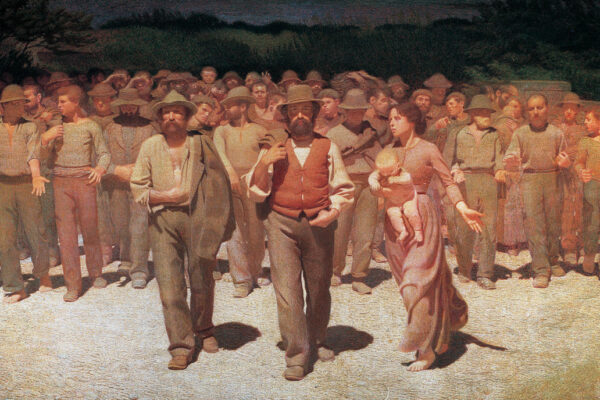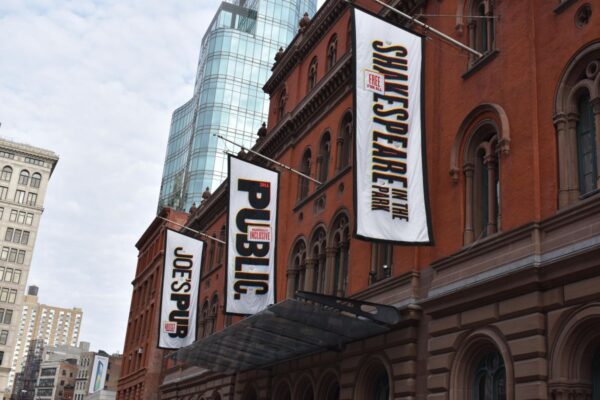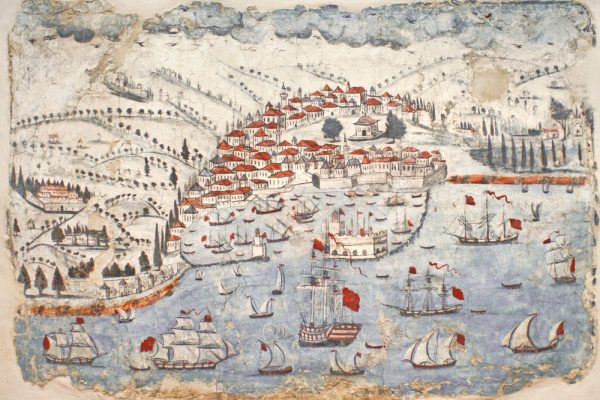Pianist Gregorio Nardi, who was a prize–winner at the Arthur Rubinstein competition in Tel Aviv and the Franz Liszt competition in Utrecht, is highly active as a concert pianist but also writes reviews and essays on the history of piano interpretation, the relationship between music and the visual arts, and the works of Jewish composers.
Image: Leone Sinigaglia
This article was originally published by the Orel Foundation and is republished with minor edits by permission.
In Italy there is absolutely no differentiation between Jews and non–Jews, in all fields, from religion to politics to the military to the economy… Italian Jews have their new Zion here, in this adorable land of ours.” These words by Benito Mussolini, the founder of fascism, were published in 1920 in Il Popolo d’Italia, the newspaper of which he was editor–in–chief. And yet, one year earlier Mussolini had inveighed, in the same newspaper, against the occult powers of “International Judaism.” Thus, by following denigration with reassurance, he began the slow process of building up racist philosophy, which had appeared to have become extraneous to Italian culture once the country’s unification was completed in 1870.
At that time, Jewish communities were nearly perfectly integrated into Italian life, and open anti–Semitic hostility was limited to a few small Catholic groups. Although Jews accounted for only about 0.1 percent of the population, many of them had held prestigious positions: there had been dozens of Jewish senators, two prime ministers (Sidney Sonnino and Luigi Luzzatti), the most esteemed mayor of Rome (Ernesto Nathan) and, during the First World War, some fifty generals, including Emanuele Pugliese, the most decorated Italian general.
Several Jewish musicians held important teaching positions: suffice it to mention such diverse personalities as the pedagogue Edgardo Del Valle de Paz (Alexandria, Egypt 1861 — Florence 1920); the composer Giacomo Orefice (Vicenza 1865 — Milan 1922), who founded the Friends of Music in Milan and was artistic director of the Teatro Costanzi in Rome; the great pianist Ernesto Consolo (London 1864 — Florence 1931), who was admired by Mahler and Toscanini. There were Jews among Mussolini’s strongest adversaries but also among his most important financiers — businessmen who were hostile to communism.
When fascism came to power at the time of the March on Rome (October 1922), the violent attacks on political opponents were not racist in character. Some Jews held important positions as members of the Grand Council of Fascism, a vice–director of the police, a minister of finance, the vice–governor of Libya and even Mussolini’s lover and first biographer, Margherita Sarfatti.
The apparently peaceful cohabitation of the fascist government with Italy’s Jewish communities lasted several years. In the Conversations with Mussolini that Emil Ludwig (originally Emil Cohn) published in 1932, the Duce described racism as “idiotic”, and following the advent of Nazism (January 1933) he saw to it that Jewish refugees from Germany were accepted without difficulty. And yet, from fascism’s outset, and beginning with the educational reforms that included obligatory Catholic instruction, a series of directives and actions contrary to the principles of freedom put an end to equality between Jews with non–Jews. Nor was any Jew ever admitted to the Accademia d’Italia (founded in 1926), membership in which was decided by Mussolini.
For musicians, the first disquieting signal came at the end of 1933 in the form of a ban on radio broadcasts of pieces by Jewish composers (the editor coudl not find evidence of this ban in Italy). The decision came from on high, but it did not reflect public opinion, which was not at all opposed to Jewish culture. Indeed, no one was surprised by the enormous success of Lodovico Rocca’s opera Il Dibuk (The Dybbuk), based on a text by S. An-Sky and produced at La Scala in Milan in March 1934. Given the peaceful atmosphere, older Jewish composers felt that they could gently bring their careers to a close. Alberto Franchetti (Turin, 1860 — Viareggio, 1942) had withdrawn into private life following the early success of such operas as Cristoforo Colombo and Germania. Leone Sinigaglia (Turin, 1868 — Turin, 1941) also enjoyed a degree of authority, and this led to his election, in 1936, to the Accademia di Santa Cecilia. Sinigaglia had been a friend of Brahms and a pupil of Dvořák; at the latter’s suggestion, he had arranged a series of fascinating Piedmontese folksongs, on which his fame is based.
New prospects seemed to be opening up for younger Jewish composers. Renzo Massarani (Mantua, 1898 — Rio de Janeiro, 1975) was considered a representative of fascist officialdom: he had participated in the March on Rome, and his compositions were heard at all major artistic events — to such an extent that despite Nazi policies his Danza Atletica was entered in the international music competition at the 1936 Berlin Olympics. Mario Castelnuovo–Tedesco (Florence, 1895 — Los Angeles, 1968) was considered, abroad, the most significant Italian composer of his generation and was performed by artists of the caliber of Gieseking, Heifetz, Piatigorsky and Segovia.
He was simultaneously friendly with Carlo and Nello Rosselli, the regime’s principal opponents (both Jews, and both assassinated in 1937), but also with Alessandro Pavolini, who later became a fanatical, cruel fascist leader. Castelnuovo was critical of the regime but knew how to take advantage of the opportunities that it offered him. Although he had openly protested against the radio ban, in 1935, at Mussolini’s request, he wrote the incidental music for Rino Alessi’s play Savonarola (a text that may have been too compromising for Catholics), which was performed at the Maggio Musicale Fiorentino.
Works by Jewish composers were officially commissioned as late as 1937, when, at the International Chamber Music Festival in Venice, Arnold Schoenberg’s Suite, Op. 29, and pieces by Massarani, Castelnuovo–Tedesco and Vittorio Rieti were performed. Rieti (Alexandria, Egypt, 1898 — New York, 1994) lived mainly in Paris, where he worked with Les Six and Diaghilev’s Ballets Russes, whereas in Rome he composed for the Cines Cinematographic Society.
It is clear that, unlike the Nazi regime, its fascist counterpart was not at all worried about artistic progressivism.
At the Venice festival in the early 1930s, works by Achron, Bartók, Bloch, de Falla, Gershwin, Hindemith, Honegger, Ibert, Kodály, Krenek, Milhaud, Poulenc, Prokofiev, Roussel, Saminsky, Stravinsky, Szymanowski, Tansman, Turina and Walton were heard. In 1934, Hermann Scherchen conducted Berg’s Der Wein in the composer’s presence, and Berg’s music was programmed in fascist Italy as late as October 8, 1942, when Wozzeck had its Italian premiere at Rome’s Teatro Costanzi under the baton of Tullio Serafin, despite opposition from Germany, where the opera had been declared an example of “degenerate art” — although Berg was an “Aryan”.
Clumsy attempts to imitate Hitler’s policies were applied superficially, and the reactionary manifestoes that appeared from time to time — beginning with one signed by Pizzetti, Respighi and others in 1932 — were never formally sanctioned, although they called for vigorous fascist solutions to supposed musical decadence. Even jazz, which was gradually being forbidden for political and racial reasons, was secretly liked and listened to by Mussolini and many other party leaders.
In any case, the cultural situation was not relaxed. In 1926 Mussolini did not attend the world premiere of Puccini’s Turandot, because Arturo Toscanini (Parma, 1867 — New York, 1957), who called the Duce “the great delinquent,” had refused to conduct the fascist anthem, Giovinezza, before the performance. Five years later, in Bologna on May 14, 1931, Toscanini was again asked to conduct the anthem; he refused, and when he arrived at the theater a group of fascists attacked and slapped him. He was advised to leave the city, and he refused to conduct again in Italy (which he later abandoned for the United States) until after the war.
Another serious episode took place in 1934: despite the success that the opera La favola del figlio cambiato — by Gian Francesco Malipiero (Venice, 1882 — Treviso, 1973) on a libretto by Luigi Pirandello, who received the Nobel Prize that year — had had at Braunschweig two months earlier, Mussolini banned it after only one performance in Italy: he was probably put out by the polemics over the subject of political hegemony. Shortly thereafter, Massimo Mila (Turin, 1910 — Turin, 1988), who was later recognized as Italy’s most important musicologist, and who had already been arrested in 1929 for antifascist activities, was put in prison, where he remained from 1935 to 1940.
It was in 1936 that specifically racist policies were set forth in circles close to the government. These were consolidated in 1938 with the promulgation of the so–called Racial Laws, which precipitated the situation. People “belonging to the Hebrew race” were expelled from all public positions. Jewish performers were banned from concert halls, as were works by Jewish composers.
Luigi Dallapiccola (Pisino, 1904 — Florence, 1975), who had initially been a fascist, was one of the non–Jewish musicians who reacted resolutely against the shameful regulations. For those who already had contacts with foreign musical circles, the wisest choice was emigration. The pianist Gualtiero Volterra (Florence, 1901 — Florence, 1967) fled to Australia, following the example of his teacher and friend Ignaz Friedman, but two of his brothers did not follow his example and were later murdered at the Mauthausen concentration camp. Castelnuovo–Tedesco, too, together with his family, sadly left his beloved Florence in 1939, shortly before the war began: Toscanini, Heifetz and Albert Spalding guaranteed work for him in the United States, where he remained for the rest of his life and enjoyed much success in the film industry. Rieti did not return to Rome from Paris, and in 1940 he, too, immigrated to America.
Massarani’s departure was the most traumatic, given his political past: when his music was banned, he immigrated to Brazil where, as if out of spite, he did all he could to insure that his works would never be played, forbade their republication and performance and made it extremely difficult to find them.
Others removed themselves from social life and went into a sort of internal exile. Jewish musicologists were forced to interrupt their research. Alberto Gentili (Vittorio Veneto, 1873 — Milan, 1954), to whom we owe the fundamental rediscovery of Vivaldi’s instrumental works, spent the terrible war years in hiding and only afterward could see to those works’ publication; whereas the monumental study Fernando Liuzzi (Senigallia, 1884 — Florence, 1940) had undertaken on Italian musicians working in France could not be completed: it trailed off in Lully’s era. Carlo Felice Boghen (Venice, 1869 — Florence, 1945), a friend and collaborator of Busoni’s who had published many unknown masterpieces of the Italian Baroque, found himself having to give private piano lessons, in a painfully clandestine situation that was aggravated by declining health. Gino Mòdona (Florence, 1871 — Florence, 1952), who had been Castelnuovo–Tedesco’s teacher and had composed refined piano pieces and didactic works, underwent a similar experience.
As early as June 1940, foreign Jews and Jews accused of being politically opposed to the Regime were interned in Italian concentration camps, a measure that proved an effective step toward the creation of the national transit camp of Fossoli, from which a large portion of the Jews arrested in Italy were sent to Auschwitz.
As the Axis’ defeat became evident, Mussolini was deposed in July 1943 and Field Marshal Pietro Badoglio took the reins of the government. At the end of that year, the Racial Laws had not yet been revoked even in the liberated zone, perhaps due to the intervention of the Holy See, according to which the legislation “has measures that should be abrogated, yet contains others as well that are worth confirmation.”
Although the situation in the south of Italy, which was already in American hands, was quickly regularized, in the north the German and Italian SS were fanatically committed to persecuting all remaining Jews. ¹
The aged Sinigaglia was among the victims: he had thought that his advanced age had made it unnecessary for him to abandon Turin. Taken to the Mauriziano Hospital, he died of cardiac–respiratory arrest when a fascist platoon prepared to arrest him.
Guido Alberto Fano (Padua, 1875 — Tauriano di Spilimbergo, 1961), who had been a pupil of Orefice, a composer of significant chamber music and a director of the Naples and Palermo conservatories, but who had been removed from all of his official positions, was in hiding in Fossombrone and Assisi beginning in 1943.
Then there was the dramatic story of Aldo Finzi (Milan, 1897 — Milan, 1945), who had composed splendid songs in the nineteen–teens and noteworthy symphonic works in the 1920s. He had been unable to take advantage of an invitation to Chicago from the soprano Rosa Raisa, because his exit permit arrived on the day that Italy declared war. In October 1944, knowing that the Italian SS militia was about to search the house where his son was staying, Finzi turned himself in, bribed the militiamen with everything he owned and managed to save himself. But four months later, his heart, overstrained by anguish, stopped beating.
One sad story has to do with popular music, and specifically with the most famous vocal group in twentieth–century Italy: the Trio Lescano, made up of three Dutch sisters (Lescano was an Italianization of the original Dutch surname, Leschan) who had arrived in Italy in 1935 and had quickly achieved extraordinary success. Their 78 r.p.m. record of the song “Tulip” sold 350,000 copies. Although they never joined the Fascist Party, they were chosen to launch the first experimental television broadcasts in 1939, and in 1941 they obtained Italian citizenship. But their Jewish origins meant that all of their programs were cancelled shortly thereafter. They were arrested in November 1943, accused of spying and imprisoned in Genoa. The ridiculous accusation was that their rhythmic songs — a witty combination of swing and jazz — contained hidden, coded messages for the enemy. While they were in prison, and because they spoke German, they were forced by the SS to be interpreters during the interrogations and torturing of captured partisans. When the war ended, they were unable to gain back the popularity they had previously known, and they quickly disappeared from the entertainment scene.
With the end of the war and the defeat of fascism, the persecution ceased. But the newfound security could not wipe out the bitter fact that most of the victims of this shameful episode were unable to enjoy the democracy that had finally been achieved, either because they had changed citizenship and decided not to return to Italy or because they had not survived to witness their country’s liberation, which took place on April 25, 1945.
Notes
¹ After being deposed, Mussolini, supported by the German allies, established the Italian Social Republic that encompassed the territory between Naples and the Alps. The leadership of the Badoglio government and the king fled South and remained under Allies’ protection. In the South, the Racial Laws were eventually abrogated after the intervention of the American Army. The Italian Social Republic, on the other hand, issued increasingly harsher measures and ordered the arrest of all Jews who had remained in its territory, whose number was between 32,000 and 35,000. The persecution of the Jews in the Italian Social Republic and its territories – the Dodecanese and a section of Southern France and Yugoslavia – resulted in the deportation of about 10,000 Jews.









